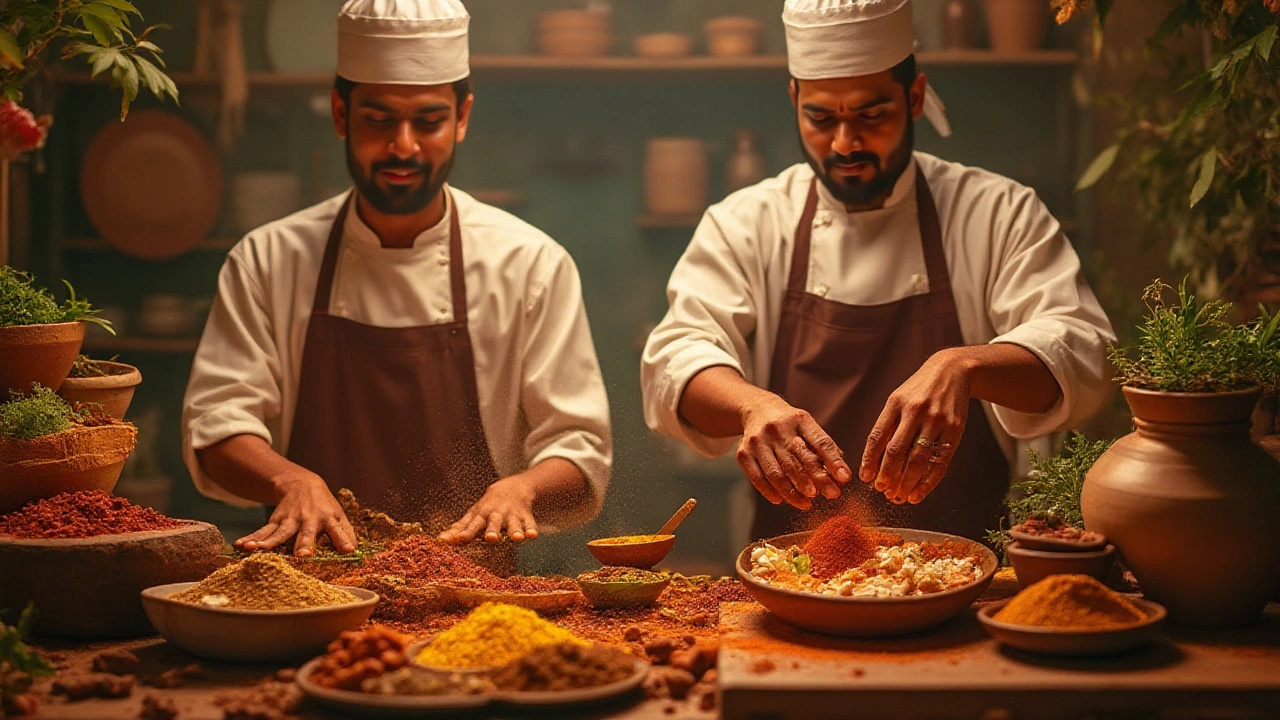Tikka vs. Tandoori Seasoning: Key Differences and Best Uses
 Aug, 2 2025
Aug, 2 2025
Ever ordered a tempting plate of chicken tikka and tandoori chicken only to wonder, "Why do they taste so different when they look almost the same?" That isn’t just your imagination. These two classic Indian dishes owe their distinct personalities to the seasoning that goes on them—one is earthy and creamy, the other is smoky and tangy. And if you’re on the fence at the grocery store, holding two nearly identical spice jars, knowing what sets tikka seasoning apart from tandoori seasoning could be the game changer for your dinner table. Spoiler: it’s not just about chili powder.
Origins and Culinary History
It’s hard to ignore just how deep tikka and tandoori roots run in Indian cuisine. Both seasonings have street cred and centuries-old stories that shape their flavor. Tandoori traces its legacy to the Punjab region, hitting menu cards way back during the Mughal era, when royal cooks were all about smoky, clay-oven-roasted dishes. The famous "tandoor" oven—basically a big clay drum—helped not just roast meats but also bread like naan and roti. Tandoori seasoning grew up alongside this oven, tuned precisely to work with extreme heat and smoky flavors.
Tikka seasoning, on the other hand, snuck into the limelight a bit later. The word "tikka" just means "bits" or "pieces" in Persian; think marinated, bite-sized morsels skewered and cooked crisp. It originally focused more on chicken and paneer, with a creamier, milder flavor profile meant to shine alongside (or inside) gravies. While tandoori is closely linked to traditional clay ovens, tikka preparations now happen both in tandoors and on stovetops or grills. The result? Tikka can feel as at home in London as it does in Ludhiana.
Both seasonings originated in the north but have spread across the world. Even British curry houses have put their own spin on tikka (hello, chicken tikka masala!). The subtle split? Tandoori leans heavily on that hard-hit smoky char, while tikka seasoning is designed to stay creamy and rich, even before the gravy hits.
In the end, every Indian kitchen—and even most takeouts—guard their own tikka and tandoori blends. What stays constant is tradition. Both these mixes are time-tested, and a grandparent somewhere is still swearing by her homemade recipe.
Here’s a fun bite: The earliest references to tandoori chicken in print show up around 1920s-30s in old Lahore (now Pakistan). Chicken tikka followed soon after, riding on the trend of “starter” plates at north Indian restaurants.
Ingredients and Spice Profiles: What’s Really Inside?
Let’s get nerdy and peek inside your spice jars. Here’s the truth—tikka and tandoori seasoning might look similar on the shelf, but crack them open, and the scents give everything away. Tandoori seasoning shouts with earthiness. It almost always has Kashmiri red chili powder for a hint of heat and striking color. You’ll also find coriander, cumin, garlic, ginger, nutmeg, black pepper, and sometimes fenugreek for an extra hit of warmth. Smoked paprika can get tossed in by modern brands, but the official OG flavor comes from actually cooking over hot charcoal or a tandoor. There’s often a touch of tang from amchur (dried mango) or even citric acid in pre-made blends—this helps cut through fattier cuts of meat.
Check out this rough snapshot of key spices for both:
| Spice | Tikka Seasoning | Tandoori Seasoning |
|---|---|---|
| Kashmiri Chili Powder | Yes (low-moderate) | Yes (high) |
| Coriander | Yes | Yes |
| Cumin | Yes | Yes |
| Garam Masala | Usually | Sometimes |
| Ginger & Garlic powder | Yes | Yes |
| Turmeric | Trace | Sometimes |
| Fenugreek leaves (Kasuri methi) | Often | Rare |
| Amchur/Citric Acid | Rare | Common |
| Black Pepper | Less | More |
| Smoked Paprika | Rare | Sometimes |
| Cream/Dairy | Common in marinade | Optional |
Tikka seasoning, by contrast, dials down the smoke and pushes up the creaminess. The flavor is smoother, thanks to generous amounts of yogurt (or cream, or even cashew paste in fancy places) in the marinade itself. Spices like fenugreek leaves and garam masala get a bigger billing here—if you’ve had butter chicken, that unmistakable aroma usually comes from the fenugreek in the tikka spice base.
Want to make your own blends? A simple tandoori mix at home is often just chili powder, coriander, cumin, a bit of turmeric, and that hit of tangy dried mango powder. For tikka, add more garam masala, use less hot chili powder, crush in some dried fenugreek, and skip the amchur.
The biggest difference? It’s about balance. Tandoori seasonings want punch and heat; tikka seasonings want a gentle, rounded cuddle of flavors. The former grabs your attention with drama, while the latter settles in and makes itself comfortable.

Preparation, Cooking, and Best Uses
For most home cooks, the saga usually starts when deciding whether to fire up the tandoor (if you’re lucky enough to have one) or make do with an everyday oven, grill, or stovetop. Traditionally, tandoori dishes are marinated with the spice blend, plenty of yogurt, and a squeeze of lemon. The yogurt here does more than just add tang—it’s a natural tenderizer, breaking down proteins and making heavier cuts of meat juicy after a hot roast. After a few hours, those hunks of chicken, fish, lamb, or even paneer get skewered and slammed into the searing-hot sides of the oven until charred and a bit smoky. Think crispy edges and that beautiful burnt-red glow. Tandoori fish and even veggies like cauliflower or potato steal the show at parties when prepared this way.
Tikka works a little differently. Its marinade, though yogurt-based as well, is thicker, sometimes creamier—from added cream, cheese, or ground cashews for richness. Here, the magic happens from letting the marinated pieces (classic pick: chicken breast) soak overnight. When it’s time to cook, tikka is usually grilled or roasted on metal skewers but can star on hot griddles, in home ovens, air fryers, or even tossed in butter on the pan. Tikka bites typically land on a platter as appetizers, with a bright kick of chaat masala and onions on the side. If not, they find themselves swimming in rich, luxurious curries—think the cult-favorite chicken tikka masala.
But what about weeknight hacks? If you’re strapped for time, remember: tandoori seasoning brings a loud punch even with fast marinades. For tikka, don’t skip resting the meat in the blend for a while—30 minutes minimum, though overnight is best. Want that restaurant look at home? A couple of drops of beetroot juice or mixed natural food coloring in the marinade create that vivid red without overdoing the chilies.
Here’s a quick breakdown of what works best where:
- Tandoori seasoning: Best for whole chicken, thighs, drumsticks, lamb chops, paneer slabs, chunky fish fillets, and potatoes. Aim for high-heat cooking. Ideal if you want strong char and a hit of smoke.
- Tikka seasoning: Best for boneless pieces such as chicken breast, paneer cubes, mushrooms, or tofu. Great inside wraps, naans, or gravies. Works on grills, oven racks, or even a stovetop pan.
Curious about calories? Tandoori marinades usually go lighter on added cream or oil (especially when cooked in a hot oven that drains off excess fat). Tikka dishes, especially the creamy gravies, lean richer but are easier to adapt by swapping cream with Greek yogurt or coconut cream. No one has to miss out due to food restrictions now. Just watch for pre-made seasoning mixes with tons of artificial color or sodium; check those labels, always.
Flavor, Aroma, and How to Choose
Crack open those spice jars and the difference jumps out—literally up your nose. Tandoori seasoning greets you with an assertive earthy punch and bold hint of citrusy tang. The chili, cumin, and coriander come through first, followed by a gentle hit of heat. If you catch a whiff of smoke, it’s either the real deal (from being cooked in a tandoor) or a dash of smoked paprika to mimic it.
Tikka seasoning smells more like Sunday lunch, cozy and gentle. The garam masala and fenugreek give it a signature savory-sweet aroma with just a dash of warmth—think of butter chicken and creamy curries wafting from Indian takeouts. The spice level stays moderate, letting the creamy components from the marinade play a starring role. Even if you dial up the heat, tikka blends rarely blast your mouth with the first bite. Instead, you get softer, layered flavors and a mellow finish.
So, which should you use tonight? Here’s a cheat sheet:
- Craving drama, smoke, and campfire flavors? Go tandoori.
- Want rich, comforting, milder heat that pairs with gravies? Pick tikka.
- Cooking for a crowd or spice-shy kids? Tikka usually lands better with picky eaters—plus leftovers go great in sandwiches, kathi rolls or salads.
- Working with a grill, oven, or air fryer? Both blends shine, but tandoori always wins for char-lover’s platters.
If you’re experimenting at home, try blending both seasonings for a best-of-both-worlds effect. Just keep an eye on the salt—pre-made mixes are salt-heavy. And seriously, skip the artificial colors. A pinch of turmeric or beet juice does the trick naturally. Modern chefs have even started dehydrating their own tandoori masala at home, then blending in fresh spices for a massive aroma hit. Or try roasting your own whole spices and grinding fresh—your neighbors might show up just from the smell.
If you ever find yourself sitting in an Indian restaurant, trying to figure out if that smoky red plate is tandoori or tikka, remember: it’s the char and bold tang that usually give tandoori away, while tikka wraps everything in a creamier, subtle hug. Both have stories to tell, and every Indian meal table is grateful for the difference.
